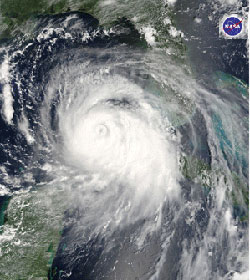Hurricanes occur during cool periods as well
Global warming may not worsen hurricanes
Hurricanes occur during cool periods as well
mongabay.com
May 28, 2007
A team of scientists have found evidence of intense hurricane activity during both cool and warm periods reports The New York Times. The findings suggest that factors other than sea temperature play a role in the formation and intensity of tropical storms.
Analyzing sediments of a lagoon on the Puerto Rican island of Vieques and in the New York, scientists from the Woods Hole Oceanographic Institution found a strong correlation between the intensity of storms along the Atlantic coast and the strength or weakness of the El Niño in the Pacific Ocean and the intensity of monsoons in West Africa.
“Comparison of the sediment record with palaeo-climate records indicates that this variability was probably modulated by atmospheric dynamics associated with variations in the El Niño/Southern Oscillation and the strength of the West African monsoon, and suggests that sea surface temperatures as high as at present are not necessary to support intervals of frequent intense hurricanes,” write Jeffrey P. Donnelly & Jonathan D. Woodruff of Woods Hole. “To accurately predict changes in intense hurricane activity, it is therefore important to understand how the El Niño/Southern Oscillation and the West African monsoon will respond to future climate change.”
 Hurricane Katrina. Courtesy of NASA |
The findings add to the complexity of understanding hurricane activity. Some scientists have warned that climate change could increase the frequency and intensity of such storms, while others have said that hurricanes occur on a cyclical basis and that we are merely in the midst of a particularly active period.
The article is published in Nature.
CITATION: Jeffrey P. Donnelly and Jonathan D. Woodruff (2007). Intense hurricane activity over the past 5,000 years controlled by El Niño and the West African monsoon. Nature 447, 465-468 (24 May 2007) | doi:10.1038/nature05834
Related articles
2007 hurricane season will be ‘very active’ but not due to global warming — 4/3/2007
Developing La Nina conditions, not global warming, should make the 2007 Atlantic hurricane season ‘very active’ according to a top U.S. hurricane forecaster. William Gray of the Department of Atmospheric Science at Colorado State University said he expects 17 named storms this year, including 9 hurricanes. He says there is a 74 percent chance that a category 3, 4, or 5 hurricane will hit the U.S. coastline (the historic average for the past century is 52 percent) and a 49 percent chance that such a storm would hit the Gulf Coast of the United States (versus an average of 30 percent for the past century).
Global warming is causing stronger Atlantic hurricanes finds new study — 3/1/2007
Global warming is fueling stronger hurricanes according to a new Geophysical Research Letters study that revises that database of historic hurricanes. Previously the hurricane database was considered inconsistent for measuring the record of tropical storms since there have been significant improvements in the technology to measure storms since recording-keeping began. Before the development of weather satellites, scientists relied on ship reports and sailor logs to record storms. The advent of weather satellites in the 1960s improved monitoring, but records from newer technology have never been squared with older data. The new study normalizes the hurricane record since 1983.
Caves may reveal if global warming is causing stronger hurricanes — 1/29/2007
Scientists have shown that cave formations could help settle the contentious debate on whether hurricanes are strengthening in intensity due to global warming. Measuring oxygen isotope variation in stalagmites in Actun Tunichil Muknal cave in central Belize, a team of researchers have identified evidence of rainfall from 11 tropical cyclones over a 23 year period (1978-2001). The research — the study of ancient storms is called paleotempestology — could help create a record of hurricanes that would help researchers understand hurricane frequency and intensity. “Tropical cyclones (including hurricanes, tropical storms, typhoons, and cyclones) produce rainwater that is different from other summertime precipitation,” explained Amy Benoit Frappier, an assistant professor in the Department of Geology and Geophysics at Boston College and lead author of the study published in Geology. “Tropical cyclones produce isotopically light rainwater primarily because 1) their cloud tops are very high and cold, and 2) their humid air tends to prevent lighter water molecules from evaporating back out of the raindrop as they fall.”